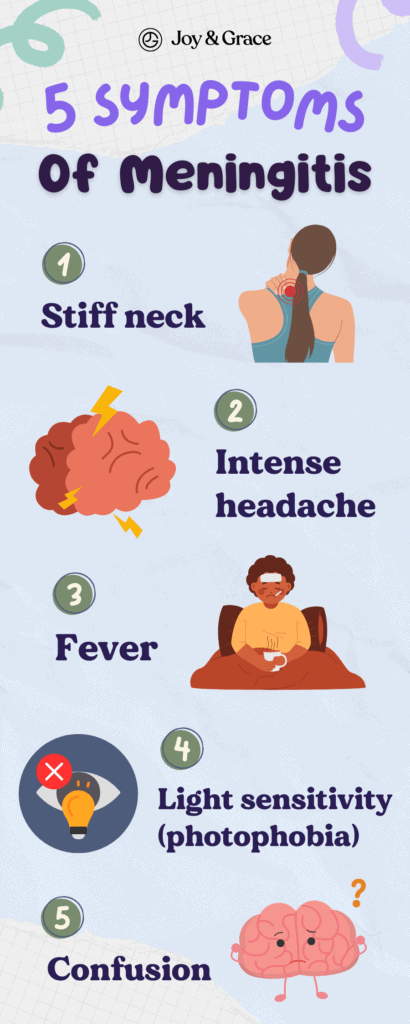Are your neck, back, and head pains random occurrences, or are they a harmless trio you shouldn't worry about? Dive into the possible connections between these discomforts and discover when it's just a coincidence and when it's time to take action.
What Does It Mean When Your Head, Neck and Back Hurt at the Same Time?

Feeling pain in your head, neck, and back at once is often due to stress, sitting awkwardly, or even just sleeping in a strange position.
A common example of this scenario is experiencing a tension headache, which feels like a tight band across the forehead, along with neck and back pain, after spending long hours hunched over a computer. Hence, it’s common for these aches to come as a package deal, but they usually aren’t serious.
But let’s not take all pain lightly; on rare occasions, these symptoms might point to serious health issues like meningitis. This is pretty unlikely if there’s no fever and the pain comes and goes. However, it’s good to know what its signs look like. Let’s explore it in more detail.
What Are The Five Symptoms Of Meningitis?

Meningitis makes the layers that cover the brain and spinal cord swell. There are five common signs of this: a stiff neck, fever, headaches that won't subside, photophobia (sensitivity to light), and confusion or altered mental status.
The traditional triad of fever, stiff neck, and mental changes is particularly common.
- The neck is very stiff in meningitis.
Neck stiffness is one of the most important signs of meningitis.
When the neck is bent forward, the swollen nerve roots and meninges in the neck area get stretched. This makes protective muscle spasms happen, which show up as stiffness in the neck.
- Headaches linked to meningitis are usually intense and ongoing.
Headaches are unusually stronger than regular headaches due to stress or tension, and they just won't let up.
- Fever is another typical symptom. The body heats up as part of its strategy to combat the infection causing the inflammation. Usually, the fever is more than 37.5°C.
- In meningitis, light sensitivity or photophobia also becomes quite evident. When inflamed, the brain is more sensitive to outside stimuli like bright light, which can cause eye pain or discomfort.
- The final symptom, confusion, occurs when inflammation disrupts the normal functioning of the brain. This can lead to a person appearing disoriented or struggling with concentration and memory. In a case we reviewed, it was observed that changes in mental state can unexpectedly appear as an early symptom, often alongside the emergence of a high fever.
Remember, these symptoms can manifest in any sequence, and not everyone with meningitis will experience all of them. Quick detection and immediate treatment of meningitis are vital to avoid severe consequences. If you or anyone else displays these symptoms, seek medical help immediately.
Can Meningitis Start With A Stiff Neck?
Yes, meningitis can indeed begin with a stiff neck.
Meningitis's stiff neck frequently causes the head to lean in a certain direction unintentionally. This is a distinctive stiffness that makes it challenging, and sometimes impossible, to touch your chin to your chest.
However, it's important to note that while a stiff neck can be a symptom of meningitis, not everyone with a stiff neck has meningitis. When someone has meningitis, they often feel stiff very quickly. They also usually have other symptoms like a headache, fever, or a change in their mental state.
Conversely, a person with meningitis does not always present a stiff neck.
This is especially true for babies and young children who might not yet have the developed musculature that leads to this symptom. In fact, a study noted that, in these groups, meningeal signs (i.e., stiff neck) may not be a reliable indicator of meningitis.
If you believe you might have meningitis because you're experiencing symptoms like stiffness, severe headaches, or sensitivity to light, it's crucial to visit a doctor immediately.
What Does A Meningitis Stiff Neck Feel Like?
A stiff neck brought on by meningitis is not your usual neck discomfort after a night of awkward sleeping. Its severe, long-lasting stiffness makes it hard to do easy things like twist your head or put your chin on your chest. The rigidity is pronounced and quite unlike anything you might have encountered.
A deep, throbbing pain often following this stiffness makes things even more uncomfortable. You may have a constant, gnawing pain that over-the-counter drugs don't seem to help with. Some movements we do without thinking, like nodding to agree or looking sideways, can make pain so bad that they are almost unbearable.
Can You Have Meningitis Without A Fever?
Not having a fever usually means you don’t have meningitis.
Fever is a common symptom and is found in most patients with meningitis. For instance, in a study of 283 adult patients with bacterial meningitis, fever was found to be present in 97.9% of the patients.
Meningitis becomes even more implausible if you don’t have any of the other common symptoms, such as:
- A very stiff neck,
- Severe headache,
- Altered mental status.
However, there are some exceptions to consider.
People with weaker immune systems, for example, those with conditions like HIV, people getting cancer treatment, or those who take certain medicines after an organ transplant, might not show the usual signs of fever or other symptoms.
Similarly, infants and young children may not show the typical signs adults do when they have meningitis. Therefore, it's important to watch for less specific symptoms in these groups and seek medical advice if meningitis is suspected.
Additionally, even if you're missing the typical symptoms, it's still a good idea to see a doctor if you're worried about meningitis. They're your go-to for reassurance and making sure everything's okay.
When Should I Worry About a Stiff Neck, Back and Headache?
If your neck pain and headache are joined by any of the high fever or confusion we discussed, it's a good idea to check in with a doctor. But meningitis aside, here are some other warning signs to keep an eye out for:
- Very Severe Pain: If the pain is really bad or different from any pain you've felt before, it's worth getting checked out.
- Sudden Headache: A headache that hits you out of nowhere, especially if it's extremely painful, can be a sign that you must go to the doctor.
- Other Weird Symptoms: If you start seeing things strangely, can't speak clearly, feel weak, or can't control your muscles properly, these could point to serious problems beyond a stiff neck or headache.
- Problems Moving: It is not normal to be unable to move around freely due to stiff neck or back muscles.
- Feeling Sick All Over: Your body may be battling an infection or something else serious if you also lose weight without trying, experience chills, or sweat a lot at night.
- Pain That Won't Quit: Pain that sticks around for more than a week or gets worse even when you're trying to treat it should be looked at by a doctor.
Now, let's discuss the causes of neck pain and headaches without including back pain in the mix.
Back Pain Out Of The Picture - What Is Causing My Neck Pain and Headache?

Most often, everyday factors like stress and not drinking enough water are behind neck pain and headaches.
However, if these don’t seem to fit your situation, you might want to explore the possibility of cervicogenic headaches.
Cervicogenic headaches are a common cause of neck pain and headaches. They begin in the neck, and then you feel the pain in your head.
In essence, a cervicogenic headache is a type of headache that originates from the cervical portion of the neck. Estimates show that 15-20% of the people who experience headaches are of this type.
Think about cervicogenic headaches if turning your neck seems to bring on or make your headache worse.
But if your headaches start behind your eyes or pain relief comes easy with regular painkillers, it's probably something else.
That said, if it turns out not to be cervicogenic headaches, there are still other kinds of headaches tied to neck pain. Knowing the different types can help you find the right way to fix the pain. Let’s review some of them.
Other Types of Headaches Caused by Neck Pain

Neck pain can result in different types of headaches. Knowing the types of headaches can help you identify the cause and find relief.
1. Tension Headaches
Tension-type headaches, often brought on by anxiety, stress, or muscle strain, are the most common headache type. These headaches manifest as a dull ache, tightness, or pressure that circles your forehead or the back of your head and neck. It does not typically interfere with daily activities, but it can become chronic, presenting itself more frequently.
2. Migraines
Migraines can often be triggered or worsened by stress or neck discomfort.
These headaches cause intense, throbbing pain, predominantly on one side of the head. Accompanying symptoms can include nausea, vomiting, and sensitivity to light and sound. Neck discomfort often precedes a migraine episode, serving as an early warning sign.
Some people also experience neck pain during or after the migraine.
3. Occipital Neuralgia
Occipital neuralgia is characterized by inflammation or damage to the occipital nerves, which travel from the top of the spinal cord up through the head.
This condition can trigger intense headaches that feel like sharp, jabbing electric shocks in the back of the head and neck. The pain typically starts at the base of the skull and spreads upwards over the scalp, sometimes reaching the forehead and the area behind the eyes. Additional symptoms can include light sensitivity or a tender scalp.
Takeaway
To sum everything up:
- It's common for neck and back pain, and headaches to occur together due to everyday stress and activities. It’s crucial to know when these pains are normal and when they might be something more.
- While it’s rare, knowing the symptoms of meningitis, like a stiff neck, terrible headache, and fever, could save lives. If you’re experiencing these, seek medical help at once.
- Not every case of neck and headache pain is alarming. But if your symptoms are severe or sudden, like a headache that comes out of the blue and is extremely painful, get it checked out.
- Sometimes, headaches that start in your neck can be due to a condition called cervicogenic headaches. If turning your neck triggers or worsens your headache, this could be the culprit.
- Different types of headaches can arise from neck issues, including tension headaches, migraines, and occipital neuralgia. Knowing what you’re dealing with can help you find relief faster.
As we conclude, if persistent neck and back pain, and headaches are disrupting your life, it’s wise to seek a doctor’s opinion. Early professional assessment and intervention can be crucial.















